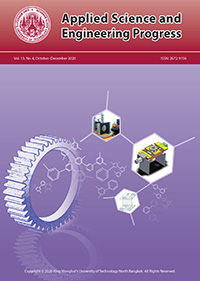Input-output Linearizing Control of Strong Acid-base Neutralization Process with Fluctuation in Feed pH
Main Article Content
Abstract
This work presents a control system design for coupled control of pH and level with fluctuation in influent pH by manipulating influent and acid flow rates. A mathematical model based on the difference between proton and hydroxide ions estimated by the measured pH is introduced and applied in a formulation of the model-based control system. A feedback controller and estimated state disturbance are obtained by solving a minimization problem of squared errors between requesting input-output linearizing output responses and the reference setpoints. To eliminate the offset response, the estimated disturbance is applied in the calculation of the closed-loop compensator. The performance of the developed control system is evaluated in a bench-scale pH neutralization process of HCl-NaOH system, and it is also compared to that of a proportional-integral controller. The results show that the developed controllers could enforce a system with fluctuation in influent pH to the desired setpoints effectively, while the PI controller gave oscillation in outputs around the setpoints and cannot achieve the desired targets.
Article Details
References
[2] J. P. Guyot, M. Calderon, and J. Morlon-Guyot, “Effect of pH control on lactic acid fermentation of starch by Lactobacillus manihotivorans LMG 18010T,” Journal of Applied Microbiology, vol. 88, no. 1, pp. 176–182, Jan. 2000.
[3] P. Li, S. E. Tabibi, and S. H. Yalkowsky, “Combined effect of complexation and pH on solubilization,” Journal of Pharmaceutical Sciences, vol. 87, no. 12, pp. 1535–1537, Dec. 1998.
[4] G. L. Williams, R. R. Rhinehart, and J. B. Riggs, “In-line process-model-based control of wastewater pH using dual base injection,” Industrial & Engineering Chemistry Research, vol. 29, no. 7, pp. 1254–1259, Jul. 1990.
[5] M. Li, F. Wang, and F. Gao, “PID-based sliding mode controller for nonlinear processes,” Industrial & Engineering Chemistry Research, vol. 40, no. 12, pp. 2660–2667, Jun. 2001.
[6] R. A. Wright and C. Kravaris, “Nonlinear control of pH processes using the strong acid equivalent,” Industrial & Engineering Chemistry Research, vol. 30, no. 7, pp. 1561–1572, Jul. 1991.
[7] R. A. Wright, M. Soroush, and C. Kravaris, “Strong acid equivalent control of pH processes: An experimental study,” Industrial & Engineering Chemistry Research, vol. 30, no. 11, pp. 2437– 2444, Nov. 1991.
[8] S. E. Hurowitz, A. Bobkov, and J. B. Riggs, “pH control using advanced proportional−integral controls with the dual-injection in-line process,” Industrial & Engineering Chemistry Research, vol. 39, no. 7, pp. 2418–2426, Jul. 2000.
[9] J. Y. Lin and C. C. Yu, “Automatic tuning and gain scheduling for pH control,” Chemical Engineering Science, vol. 48, no. 18, pp. 3159– 3171, Sep. 1993.
[10] J. Zhang, “A nonlinear gain scheduling control strategy based on neuro-fuzzy networks,” Industrial & Engineering Chemistry Research, vol. 40, no. 14, pp. 3164–3170, Jul. 2001.
[11] M. R. Pishvaie and M. Shahrokhi, “pH control using the nonlinear multiple models, switching, and tuning approach,” Industrial & Engineering Chemistry Research, vol. 39, no. 5, pp. 1311–1319, May 2000.
[12] M. A. Henson and D. E. Seborg, “Adaptive nonlinear control of a pH neutralization process,” IEEE Transactions on Control Systems Technology, vol. 2, no. 3, pp. 169–182, 1994.
[13] A. P. Loh, D. S. De, and P. R. Krishnaswamy, “pH and level controller for a pH neutralization process,” Industrial & Engineering Chemistry Research, vol. 40, no. 16, pp. 3579–3584, Aug. 2001.
[14] J. C. Gomez, A. Jutan, and E. Baeyens, “Wiener model identification and predictive control of a pH neutralisation process,” IEE Proceedings - Control Theory and Applications, vol. 151, no. 3, pp. 329–338, May 2004.
[15] M. A. Henson and D. E. Seborg, Nonlinear Process Control. New Jersey: Prentice-Hall, Inc., 1997.
[16] J. M. Kanter, M. Soroush, and W. D. Seider, “Continuous-time, nonlinear feedback control of stable processes,” Industrial & Engineering Chemistry Research, vol. 40, no. 9, pp. 2069– 2078, May 2001.
[17] D. E. Seborg, D. A. Mellichamp, T. F. Edgar, and F. J. Doyle, Process Dynamics and Control, 3rd ed. New Jersey: John Wiley & Sons, 2010.


